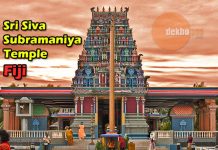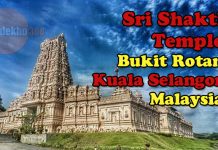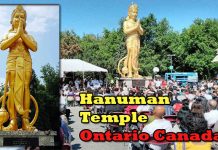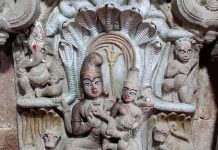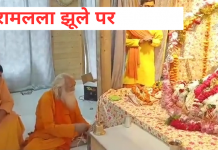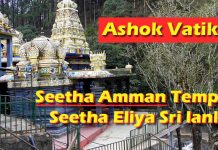Sri Harmandir Sahib, also known as Sri Darbar Sahib or Golden Temple, (on account of its scenic beauty and golden coating for English speaking world), is named after Hari (God) the temple of God. The Sikhs all over the world, daily wish to pay visit to Sri Amritsar and to pay obeisance at Sri Harmandir Sahib in their Ardas.
Guru Arjan Sahib, the Fifth Nanak, conceived the idea of creating a central place of worship for the Sikhs and he himself designed the architecture of Sri Harmandir Sahib. Earlier the planning to excavate the holy tank (Amritsar or Amrit Sarovar ) was chalked out by Guru Amardas Sahib, the Third Nanak, but it was executed by Guru Ramdas Sahib under the supervision of Baba Budha ji. The land for the site was acquired by the earlier Guru Sahibs on payment or free of cost from the Zamindars (landlords) of native villages. The plan to establish a town settlement was also made. Therefore, the construction work on the Sarovar(the tank) and the town started simultaneously in 1570. The work on both projects completed in 1577 A.D.
Guru Arjan Sahib got its foundation laid by a muslim saint Hazrat Mian Mir ji of Lahore on 1st of Magh, 1645 Bikrmi Samvat(December,1588). The construction work was directly supervised by Guru Arjan Sahib himself and he was assisted by the prominent Sikh personalities like Baba Budha ji, Bhai Gurdas ji, Bhai Sahlo ji and many other devoted Sikhs.
Unlike erecting the structure on the higher level(a tradition in Hindu Temple architecture), Guru Arjan Sahib got it built on the lower level and unlike Hindu Temples having only one gate for the entrance and exit, Guru Sahib got it open from four sides. Thus he created a symbol of new faith, Sikhism. Guru Sahib made it accessible to every person without any distinction of Caste, creed, sex and religion.
The building work completed in 1601 A.D. on Bhadoon Sudi 1st, 1661 Bikrmi Samvat (August/September,1604). Guru Arjan Sahib installed newly created Guru Granth Sahib, in Sri Harmandir Sahib and appointed Baba Budha ji as its first Granthi i.e. the reader of Guru Granth Sahib. After this event it attained the status of ‘Ath Sath Tirath’. Now the Sikh Nation had their own Tirath, a pilgrimage center
Sri Harmandir Sahib, is built on a 67ft. square platform in the centre of the Sarovar(tank). The temple itself is 40.5ft. square. It has a door each on the East, West, North and South. The Darshani Deori (an arch) stands at the shore end of the causeway. The door frame of the arch is about 10ft in height and 8ft 6inches in breath. The door panes are decorated with artistic style. It opens on to the causeway or bridge that leads to the main building of Sri Harmandir Sahib. It is 202 feet in length and 21 feet in width.
The bridge is connected with the 13 feet wide ‘Pardakshna’ (circumambulatory path). It runs round the main shrine and it leads to the ‘Har ki Paure’ (steps of God). On the first floor of ‘Har ki Paure’, there is continuous reading of Guru Granth Sahib.
The main structure of Sri Harmandir Sahib, functionally as well as technically is a three-storied one. The front, which faces the bridge, is decorated with repeated cusped arches and the roof of the first floor is at the height of the 26 feet and 9 inches.
At the top of the first floor 4 feet high parapet rises on all the sides which has also four ‘Mamtees’ on the four corners and exactly on the top of the central hall of the main sanctuary rises the third story. It is a small square room and have three gates. A regular recitation of Guru Granth Sahib is also held there.
On the top of this room stands the low fluted ‘Gumbaz’(dome) having lotus petal motif in relief at the base inverted lotus at the top which supports the ‘Kalash’ having a beautiful ‘Chhatri’ at the end.
Its architecture represents a unique harmony between the Muslims and the Hindus way of construction work and this is considered the best architectural specimens of the world. It is often quoted that this architecture has created an independent Sikh school of architecture in the history of art in India.
A visit to the Harmandir Sahib is incomplete without a visit to the following among others-
1. AKAL TAKHAT
It rightly faces the Harmandir Sahib. Built by the Sixth Master Guru Hargobind (1606-44) in 1609, has been the nerve centre or the Sikhism ever since. All commandments affecting the community as a whole were and are issued from here. The Akal Takhat was used for holding court and Sikh congregations in the days of its builder.
The Akal Takhat was pulled down several times by the Muslim raiders. The ground floor of the present building was constructed in 1 874. Three storeys were subsequently added by Maharaja Ranjit Singh. A number of weapons used by Guru Hargobind, Guru Gobind Singh and other Sikh heroes are preserved at Akal Takhat. In 1984 during Operation Blue Star Akal Takhat was badly damaged by the Indian Army.
2. BABA ATAL
A nine-storeyed tower, built in memory of Atal Rai (D. 1628), a son of Hargobind, is called Baba Atal. Atal Rai died at nine. He was called ‘Baba’ (an old man) head over young shulders. The tower was built between 1778 and 1784. It is the only of its kind in the city with 108 ft. height.
3. GURU KA LANGAR
A Sikh temple without a Community Kitchen is inconceivable. Cooked food is serviced in the kitchen of the Harmandir Sahib 24 hours to all visitors irrespective of religion, caste, creed and nationality. The expenses are met out of the Temple funds. Approximately 40,000 visitors share the meals everyday presently.
4. SRI GURU RAM DAS NIWAS
The Niwas is a free hostel for the pilgrims maintained by the Temple authorities. It has been built by the Gurdwara Committee. It has 228 rooms and 18 big halls. Unlike the ordinary ‘Daramsalas’ the Niwas supplies the facilities of free beddings, cots, lights and fans etc. to the lodgers. A lodger is not generally allowed to stay here for more than three days at a time. The doors of the hostels are open to all. The lodgers however must not do anything repugnant to the teachings of Sikhism.
5. GURU NANAK NIWAS
There are 66 Rooms in Guru Nanak Niwas-22 with attached baths and 4-4 without baths, but on each floor there are 10 bath rooms and fen flush latrines so as to make stay comfortable.
6. AKAL REST HOUSE
There is Akal Rest House having 26 rooms with double beds and attached bath rooms are provided on a nominal Rent.
7. GURU HARGOBIND NIWAS
There are 92 double bed rooms with attached bath in addition to four halls. Rooms are available at Rs. 50/- per day.
8. GURU ARJAN DEV NIWAS
An accomodation adjacent to Guru Nanak Niwas with 1 00 rooms coming up.
9. THE SGPC OFFICES
The headquarters of the Shiromani Gurdwara Parbandhak Committee are located in the Teja Singh Samundri Hall near the Harmandir Sahib. The Gurdwara Act 1925, transferred the control of the historical Sikh Shrines in the Punjab to the SGPC. It is a representative body of the Sikhs elected by adult franchise.
Among the other objects of interest around the Harmandir Sahib worth mentioning are :
(a) Dukh Bhanjni Ber (Jujube Tree)
(b) Thara Sahib
(c) Ber Baba Budha Ji
(d) Gurdwara llachi Ber
(e) Ath Sath Tirath (Sixty eight holy places condensed into one) &
(f) Gurdwara Shaheed Bunga Baba Deep Singh.
The Harmandir Sahib possesses a fine collection of jewellery and valuable articles of considerable artistic and historical importance. The following deserve a special mention :
(a) GOLDEN DOOR PANELS – There are four pairs of them.
(b) GOLDEN CANOPY – The canopy studded with precious jewels, is an object of exquisite workmanship and great artisitic value.
(c) JEWELLED HEAD-BAND- It is a gift from Maharaja Ranjit Singh. It was prepared for the marriage of the son of Maharaja Ranjit Singh, at the time of marriage. The Maharaja presented it to the Harmandir Sahib.
10. CENTRAL SIKH MUSEUM-
Central Sikh Museum has paintings of Sikh Gurus, Saints, Sikh warriors and other prominent Sikh leaders who have in their own way contributed a lot to the enhancement of Sikh Religion.
Online Darshan : Click here
Temple Timings : Click here
Website : Click here
Nearest City/Town : Amritsar
State : Punjab
Country : India
Address :
Shiromani Gurdwara Parbandhak Committee,
Teja Singh Samundri Hall, Sri Harmandir Sahib Complex, Amritsar.
Tel. : 0183-2553957-58-59
Email : info@sgpc.net
Nearby places to visit : Click here






